 W
WThe 3 cm MK 303 Flak and twin-mounted 3 cm MK 303 Flakzwilling (M44) were experimental 30 mm anti-aircraft guns developed in Nazi Germany. They fired the powerful 30x210mm round and only 222 were produced. The gun was to be installed on Type XXI submarines as AA defense and its use as AA defense replacing 2 cm Flak and 3.7 cm Flak weapons was also considered. The use of 3 cm M.K. 303 Flakzwilling on Flakpanzer IV "Kugelblitz" was considered, but rejected. The development began in late 1941 and production started in late 1944.
 W
WThe 30 mm/82 Compact is a naval autocannon built by Alenia Marconi Systems and Oto-Breda, using the Mauser MK 30 mm Model F gun.
 W
WThe 30mm DS30M Mark 2 is a ship-protection system made by MSI-Defence Systems consisting of a 30mm Mark 44 Bushmaster II cannon on an automated mount. It was designed to defend Royal Navy frigates from fast inshore attack craft armed with short-range missiles, rockets, rocket-propelled grenades, heavy machine guns or explosives. It replaced in this role the 30mm Oerlikon KCB gun or the DS30B rapid fire cannon, a similar powered mounting. The DS30M has also been added to patrol boats and corvettes for the Iraqi and Omani navies respectively.
 W
WThe Royal Small Arms Factory ADEN is a 30 mm revolver cannon used on many military aircraft, particularly those of the British Royal Air Force and Fleet Air Arm. Developed post-World War II primarily to meet British Air Ministry's requirement for increased lethality in aircraft armament, the cannon was fired electrically and is fully automatic once it is loaded.
 W
WThe AK-230 is a Soviet fully automatic naval twin 30 mm gun. Its primary function is anti-aircraft. It is mounted in an enclosed automatic turret and directed by radar. AK-230 is widely used, mounted on big warships as well as small craft. About 1450 guns were produced in the USSR, and about 300 were produced in China as the Type 69. It was succeeded by the more powerful AK-630 from the mid-to-late 1970s.
 W
WThe AK-630 is a Soviet and Russian fully automatic naval close-in weapon system based on a six-barreled 30 mm rotary cannon. In "630", "6" means 6 barrels and "30" means 30 mm. It is mounted in an enclosed automatic turret and directed by MR-123 radar and television detection and tracking. The system's primary purpose is defense against anti-ship missiles and other precision guided weapons. However it can also be employed against fixed or rotary wing aircraft, ships and other small craft, coastal targets, and floating mines. Once operational, this weapon system was rapidly adopted, with up to 8 units installed in every new Soviet warship, and hundreds produced in total.
 W
WThe Artemis 30 is an anti-aircraft gun system originally developed in 1982 and produced by the Hellenic Arms designed by Anastasios Georgiou (EBO) and Athanassios Calligeris, Ph.D. Designer lots parts of twin barrels for use by the Greek armed forces in the Aegean sea. The system is named after the ancient Greek goddess of the hunt, Artemis.
 W
WThe Close Range Naval-91 is a naval version of the Medak 30mm automatic gun installed on the Sarath Infantry fighting vehicle, a variant of the Russian BMP-2 manufactured in India under license by the Ordnance Factory Medak. The Medak gun itself is based on the Russian Shipunov 2A42 30 mm automatic cannon.
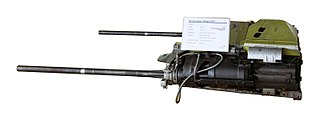 W
WThe DEFA cannon is a family of widely used French-made aircraft revolver cannon firing standard 30 mm caliber NATO rounds.
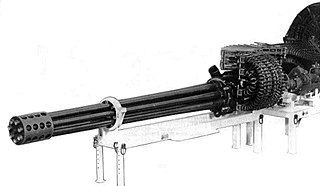 W
WThe General Electric GAU-8/A Avenger is a 30 mm hydraulically driven seven-barrel Gatling-style autocannon that is typically mounted in the United States Air Force's Fairchild Republic A-10 Thunderbolt II. Designed specifically for the anti-tank role, the Avenger delivers very powerful rounds at a high rate of fire. The GAU-8/A is also used in the Goalkeeper CIWS ship weapon system, which provides defense against short-range threats such as highly maneuverable missiles, aircraft, and fast maneuvering surface vessels. The GAU-8/A is currently produced by General Dynamics.
 W
WThe General Electric GAU-13/A is a 30 mm electric Gatling-type rotary cannon derived from the GAU-8 Avenger cannon.
 W
WThe GIAT 30 is a series of 30 mm cannon developed to replace the DEFA 550 series weapons on French military aircraft.
 W
WGoalkeeper is a Dutch close-in weapon system (CIWS) introduced in 1979. It is an autonomous and completely automatic weapon system for short-range defence of ships against highly manoeuvrable missiles, aircraft and fast-manoeuvering surface vessels. Once activated the system automatically undertakes the entire air defence process from surveillance and detection to destruction, including the selection of the next priority target.
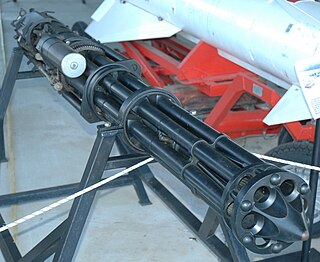 W
WThe Gryazev-Shipunov GSh-6-30 is a Russian 30 mm rotary cannon aircraft-mounted and naval autocannon used by Soviet and later CIS military aircraft. The GSh-6-30 fires a 30×165mm, 390 g projectile.
 W
WThe Gryazev-Shipunov GSh-30-1 is a 30 mm autocannon designed for use on Soviet and later Russian military aircraft, entering service in the early 1980s. Its current manufacturer is the Russian company JSC Izhmash.
 W
WThe Gryazev-Shipunov GSh-30-2 (ГШ-30-2) or GSh-2-30 is a Soviet dual-barrel autocannon developed for use on certain ground attack military aircraft and helicopters.
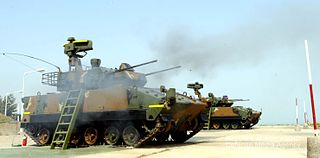 W
WThe South Korean K30 Biho twin 30 mm self-propelled anti-aircraft weapon was developed to meet the operational requirements of the Republic of Korea Armed Forces for a highly mobile short range air defense system suited to the operational and terrain conditions of the Korean peninsula. It combines an electro-optically guided 30 mm gun system with a surveillance radar system on a K200 chassis. It supplements the K263A1 Chungung, a self-propelled 20 mm Vulcan system.
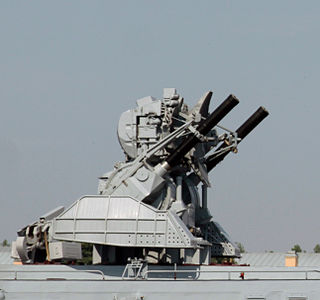 W
WThe Kortik close-in weapon system (CIWS) is a modern naval air defence gun-missile system deployed by the Russian Navy. Its export version is known as Kashtan, with the NATO designation CADS-N-1 Kashtan.
 W
WThe Flakpanzer IV Kugelblitz was a German self-propelled anti-aircraft gun developed during World War II. By the end of the war, only a pilot production of five units had been completed. Unlike earlier self-propelled anti-aircraft guns, it had a fully enclosed, rotating turret.
 W
WThe M230 Chain Gun is a 30 mm (30×113 mm), single-barrel chain-driven autocannon, using external electrical power to cycle the weapon between shots. It was designed and manufactured originally by Hughes Helicopters in Culver City, California. The company was acquired by McDonnell Douglas Helicopters in 1985, which merged into Boeing Corporation in 1997. In 2002, it was sold again to Alliant Techsystems, which merged with Orbital Sciences Corporation in 2015 to form Orbital ATK and was, in turn, bought out by Northrop Grumman in 2018. As of 2019, it is produced by Northrop Grumman Innovation Systems.
 W
WThe Medak Gun is 30mm automatic cannon. It is primarily an army gun used on Sarath infantry armoured vehicle. It is based upon the Shipunov 2A42 gun used in the Russian-designed BMP-2 infantry fighting vehicle.
 W
WThe MK 101 is the designation of a 30 mm autocannon used in German combat aircraft during World War II. Although accurate and powerful, with a high muzzle velocity, it was very heavy, with a low rate of fire, which limited its production.
 W
WThe MK 108 was a 30 mm caliber autocannon manufactured in Germany during World War II by Rheinmetall‑Borsig for use in aircraft.
 W
WThe Mk44 Bushmaster II is a 30 mm chain gun manufactured by Northrop Grumman. It is a derivative of the 25 mm M242 Bushmaster, and uses 70% of the same parts as the M242 while increasing the firepower by as much as 50% with the 20% increase in caliber size. The barrel is chromium-plated for extended life. The gun uses standard GAU-8 Avenger ammunition that is available in API, HEI and APFSDS-T variants. The gun can be converted to a caliber of 40x180 mm, which involves changing the barrel and a few key parts, to use the SuperShot 40 cartridge. It can also be converted to use the 30x170 mm RARDEN cartridge.
 W
WThe Nudelman-Rikhter NR-30 was a Soviet autocannon widely used in military aircraft of the Soviet Union and Warsaw Pact. It was designed by A.E. Nudelman and A. A. Rikhter, entering service in 1954.
 W
WThe Oerlikon 30 mm twin cannon is an anti aircraft gun used by the Royal Navy. They were fitted to Type 42 destroyers after the Falklands War to improve defence against air attack.
 W
WThe Oerlikon KCA is a Swiss 30 mm (1.181 in) gas-operated single-barrel revolver cannon developed for aircraft use. Its most noticeable use was on the Saab 37 Viggen fighter mounted on a conformal pod. The KCA fires a 30 mm × 173 mm shell that is 50% heavier than the NATO standard ammunition used on ADEN and DEFA cannon. It can fire up to 1350 rounds per minute at a muzzle velocity of 1030 m/s, with an effective range of 2,500 m (8,200 ft)
 W
WPantsir-M is a Russian jamming-resistant naval close-in weapon system (CIWS) which entered service in 2018. Pantsir-M is equipped with friend or foe identification system and armed with naval version of the Pantsir's 57E6 missiles and Hermes-K missiles. Its secondary armament are two six-barreled 30×165mm GSh-6-30K/AO-18KD rotary cannons. Same as on Kashtan-M. Pantsir-M is fully automated and can engage up to four targets simultaneously at a range of up to 20 km and can operate as a battery of up to four modules. Pantsir-M can intercept sea skimming missiles flying as low as two meters above the surface. If a target isn't sufficiently destroyed by Pantsir's missile attack it can automatically direct its cannons against it. Pantsir-M's phased array radar, electro-optical/infrared targeting and identification system are based on that of Pantsir's 1RS2-1.
 W
WThe L21A1 RARDEN is a British 30mm autocannon used as a combat vehicle weapon. The Royal Armament Research and Development Establishment (RARDE) and the Royal Small Arms Factory (RSAF), Enfield, at the time, were both part of the Ministry of Defence.
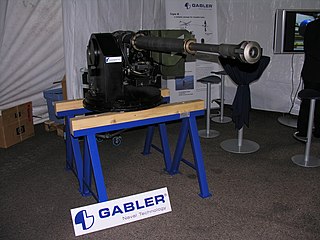 W
WThe RMK 30 is a recoilless 30 mm caliber autocannon firing caseless 30 × 250 mm ammunition cartridges. The gun was developed by the German company Mauser, which is now a subsidiary of the Rheinmetall group.
 W
WThe Shipunov 2A42 is a Soviet/Russian 30 mm autocannon. It is built by the Tulamashzavod Joint Stock Company.
 W
WThe Type 730 is a Chinese seven-barrelled 30 mm Gatling gun CIWS. It has a PLA Navy designation H/PJ12. It is mounted in an enclosed automatic turret and directed by radar, and electro-optical tracking systems. The maximum rate of fire is 5800 rd/m, and the effective range is up to 3 km.